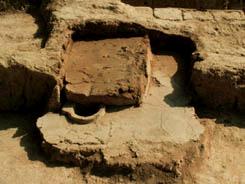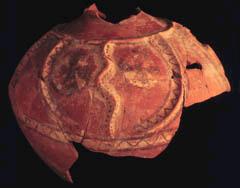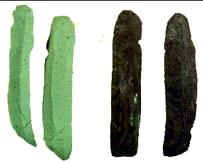|
BANESH EXCAVATIONS AT OPERATION TUV |
|||||
|
|
|||||
 |
|||||
|
Aerial View of Operation TUV from the East, 1976 |
||
|
The small TUV mound is located near the NE corner of the site. Here we see TUV near the final stage of excavation. The earliest level, BL 3B, is revealed in the half square (T168) at the lower left, in the two operations in the center foreground (U168 and V168), and in the eastern part of Operation U166. Parts of BL 2 are visible in the area where the balk between U166 and V166 was removed. The oval shaped building in V164 is an enigmatic structure that may have been a granary, probably in BL 2. The walls of the latest level (BL 1) had been removed when this picture was taken. Bibliography— Ilene Nicholas, also Blackman, Miller, Pittman, Stolper, and Zeder |
|
 |
|||
|
Hearth in TUV BL3. The domed top and flue in the wall were destroyed by later building activity. On the left the upper griddle level of the hearth was made of plaster binding together large river cobbles and thick pot sherds. A fire built on the griddle would have heated the cobbles and after the ashes were brushed off into the trough at right the hot griddle, like a heat battery, would have been ready to use. The built-in cup would have received any liquid drained off the griddle. |
|||
|
Unique bichrome painted pot with relief decoration from TUV BL 2. Fine relief decorated pottery was also found in BL 3 at ABC see ABC Layers |
|||
 |
|||
|
Stone Tools from TUV. Evidence for copper based metallurgy, abundant at TUV, included ores, slags, furnace linings, molds, copper bar stock nand sheet stock. The source of the arsenical copper was probably Anarack. Iran Map Even so, chert and flint blades and other stone tools were common. These blades were found in a disturbed deposit near a Sasanian burial,but probably belong to TUV BL 2. Evidence for flint knapping and the use of stone tools was found in all levels at Malyan. Raw materials were mostly local cherts, but obsidian was imported from the region around Lake Van and Lake Sevan. Iran Map Bibliography James Blackman, also Nicholas |
|||
 |
|||